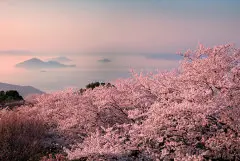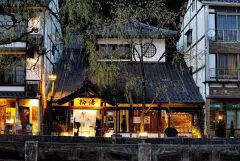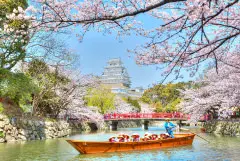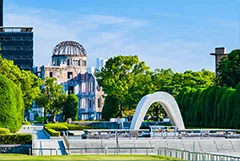Itineraries
Following Setouchi's Coastline West
Highlights
Before & After
From Shin-Osaka Station take the Tokaido-Sanyo Shinkansen Mizuho to Kokura Station (135 min). Then, transfer to the Tokaido-Sanyo Shinkansen Kodama for Shin-Shimonoseki Station (10 min). In total, the ride takes about 145 min.
Karato Market is a 30 min bus ride from the shinkansen stop at Shin-Shimonoseki
Hiroshima Station is a 160 min journey on bus, ferry and a train from Iyonada Monogatari

Deep dive into some of the Western Japan’s top sightseeing spots along the Setouchi region. Join us as we follow the coastline starting in western Yamaguchi before circling around to Ehime — a ferry ride to the south from Hiroshima Prefecture. Take in local cuisine, spectacular scenery and unique culture on this unforgettable journey.
- Day 1
- Yamaguchi
Karato Market
Begin your trip on a healthy note with a morning visit to one of Western Japan’s biggest wholesale markets at Karato Market.
Shimonoseki is commonly considered the blowfish (fugu) capital of Japan so it is worth making the most of your visit to try this local delicacy of fugu and learn why blowfish originated here.
The market also has a wide variety of fresh seafood to try, which can be sampled from the market stalls or at one of the second-floor restaurants. On weekends, you’ll encounter Ikiiki Bakangai where vendors participate in a ‘sushi battle’ offering the visiting crowds hand-rolled sushi and fugu sashimi. This event is a great way to enjoy fresh fish in a nigiri or donburi style, as well as the lively atmosphere of the market with its fresh seafood.
Kintaikyo Bridge
Originally built in 1673, the Kintaikyo Bridge is quite unlike any other bridge in Japan, with its five wooden lattice work arches gracefully straddling the Nishiki River atop giant stone pillars. Located in Iwakuni, Yamaguchi Prefecture, the original bridge was lost in a typhoon but was eventually rebuilt in 1953 and is now known as one of western Japan’s most iconic settings.
Visitors flock to the Kintaikyo Bridge throughout the year, but it is most famous during the cherry blossom season when it is warm enough to enjoy bento boxes under the trees by the river side.
Be sure to explore the grounds of Kikko Park across the river and, if time permits, take the ropeway up to the mountaintop Iwakuni Castle for a commanding view of the region.
- Day 2
- Hiroshima
Itsukushima Shrine
Kintaikyo Bridge to Itsukushima Shrine is about a 65-minute combined ferry and car ride.
Hiroshima’s Itsukushima Shrine is one of the jewels of Western Japan and is on Miyajima island, just a short ferry ride from Hiroshima’s mainland. This UNESCO World Heritage Site is famous for its vermillion red torii gate which sits proudly off the coast and appears to float at high tide. It is an instantly iconic and memorable scene and considered one of Japan’s Three Scenic Views.
The shrine itself is centuries-old, being first founded in 593, and is a joy to explore along the elevated walkways that guide visitors through vermillion tunnels and the shrine’s grounds.
No visit to Miyajima island should be rushed, and it is worth exploring the surrounding area, hiking up Mt. Misen, and trying the local oysters while you’re here. Consider staying after dark to capture the nighttime illumination of the torii gate, before boarding the ferry back to the mainland.
- Day 3
- Ehime
Iyonada Monogatari
Itsukushima Shrine to Matsuyama Station is about a 240-minute combined ferry and car ride.
The retro-modern Iyonada Monogatari (Iyonada Story) sightseeing train promises stunning, panoramic coastal views as it journeys its way along the Iyonada coastline in Ehime prefecture.
Operating mostly on weekends and public holidays, the train takes a seaside route between Matsuyama and Iyo-Ōzu and Yawatahama stations. Guests can enjoy local cuisine thanks to carefully prepared luxurious meals that use regional Ehime ingredients and are unique depending on the particular service and time of day.
As the train crosses the Hijikawa River just south of Iyo-Ōzu, admire the view of Ozu Castle on the riverbank and the beaming smiles of flag-carrying locals as they wave the Iyonada Monogatari train onwards on its way. The flag waving spectacle occurs around 15:18 and 16:30 on days when Iyonada Monogatari operates.
*Flag waving may not take place on all days.
One of the standout stops is Shimonada Station, renowned for its calm, pristine view of the ocean from the minimalist and remote station platform on the Yosan Line. The picturesque scenery has been a shooting location for a number of local TV dramas and films. While this has made it popular with photographers looking for a memorable photo, it is one of many such photogenic spots along the route.







































